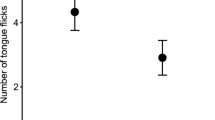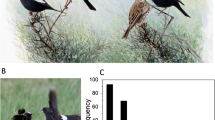Summary
The Australian sleepy lizard Trachydosaurus rugosus is a large mainly herbivorous skink, which occupies overlapping home ranges. In the Mt. Mary study area, South Australia, 6567 captures were made of 2412 different individuals between February 1982 and December 1986. The mating season when male and female lizards formed pairs was in the spring months of October and November. Some lizards were captured in pairs more than once in the same mating season. Amongst this group over 90% of females and over 70% of males were found with the same partner. These monogamous pair-bonds lasting up to eight weeks, had been predicted by Stamps (1983) for large lizards with overlapping home ranges. In addition 79% of females and 68% of males recaptured in pairs in subsequent years were found with the same partner. This mate fidelity is too high to be accounted for by chance encounters. The selective advantages of actively choosing the same partner each year are discussed.
Similar content being viewed by others
References
Brattstrom BH (1974) The evolution of reptilian social behaviour. Am Zool 14:35–49
Bull CM (1978) Dispersal of the Australian reptile tick Aponomma hydrosauri by host movement. Aust J Zool 26:689–697
Bull CM (1987) A population study of the viviparous Australian lizard, Trachydosaurus rugosus (Scincidae). Copeia 1987:749–757
Bull CM, Sharrad RD, Petney TN (1981) Parapatric boundaries between Australian reptile ticks. Proc Ecol Soc Aust 11:95–107
Carothers JH (1984) Sexual selection and sexual dimorphism in some herbivorous lizards. Am Nat 124:244–254
Cooper WE, Vitt LJ (1987) Intraspecific and interspecific aggression in lizards of the scincid genus Eumeces: chemical detection of conspecific sexual competitors. Herpetol 43:7–14
Coulson JC (1966) The influence of the pair-bond and age on the breeding biology of the kittiwake gull Rissa tridactyla. J Anim Ecol 35:269–279
Dubas G (1987) Biotic determinants of home range size of the scincid lizard Trachydosaurus rugosus (Gray). PhD Thesis, Flinders University of South Australia
Freed LA (1987) The long-term pair bond of tropical house wrens: advantage or constraint? Am Nat 130:507–525
McComb K (1987) Roaring by red deer stags advances the date of oestrous in hinds. Nature 330:648–649
Petney TN, Bull CM (1981) The area occupied by an omnivorous lizard, Trachydosaurus rugosus. Aust Wildl Res 8:435–442
Stamps JA (1983) Sexual selection, sexual dimorphism, and territoriality. In: Huey RB, Pianka ER, Schoener TW (eds) Lizard ecology. Harvard University Press, Cambridge, pp 169–204
Wilson EO (1975) Sociobiology: the new synthesis. Harvard University Press, Cambridge
Author information
Authors and Affiliations
Rights and permissions
About this article
Cite this article
Bull, C.M. Mate fidelity in an Australian lizard Trachydosaurus rugosus . Behav Ecol Sociobiol 23, 45–49 (1988). https://doi.org/10.1007/BF00303057
Received:
Accepted:
Issue Date:
DOI: https://doi.org/10.1007/BF00303057




